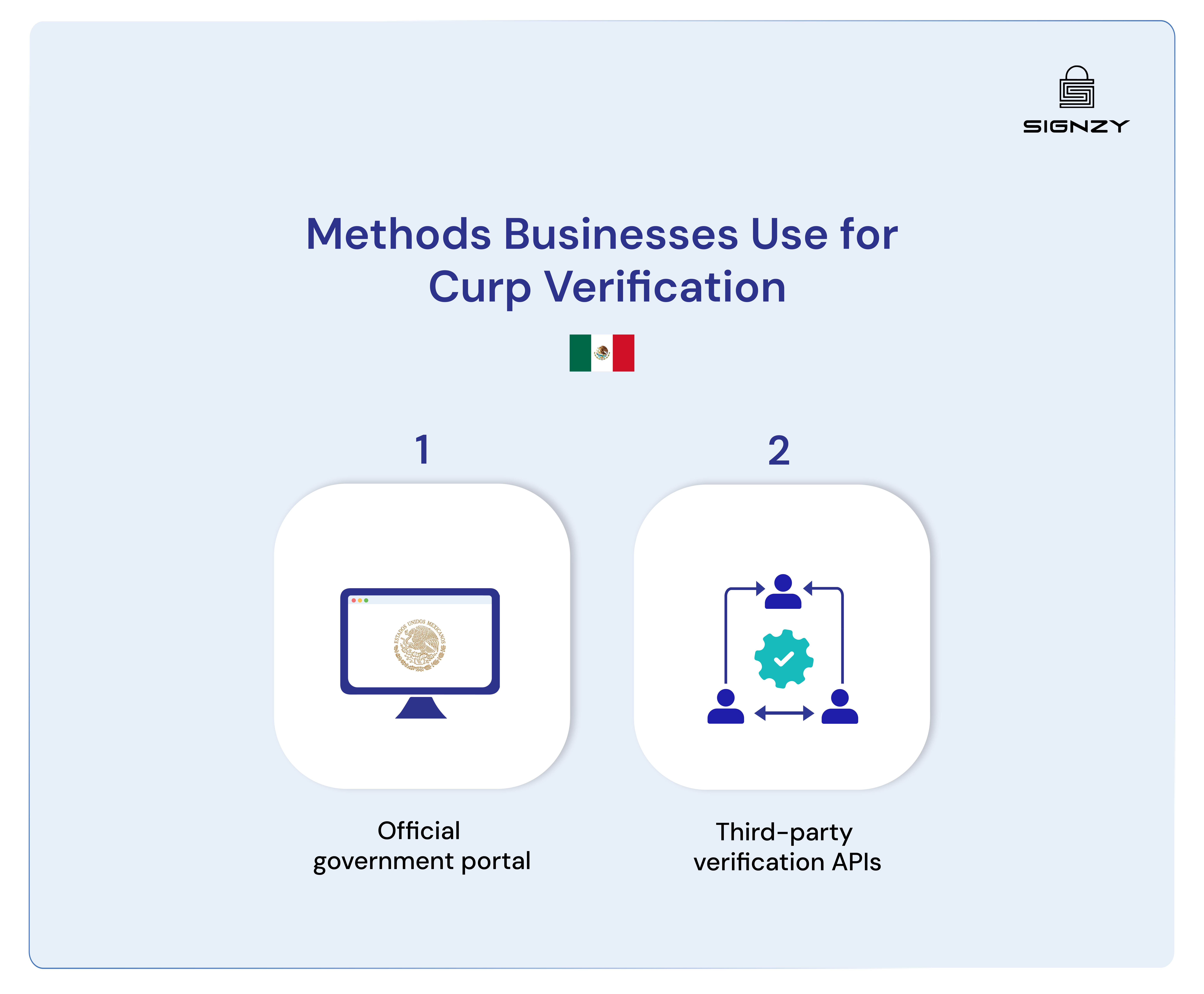Conducting CURP Verification: Overview, Process, Automation, and More
- A failed verification may indicate incorrect data entry, an invalid CURP, or identity fraud.
- Foreigners with temporary or permanent residency cards have valid CURPs that can be verified through the same systems as Mexican nationals.
- CURP and RFC aren’t the same. CURP verifies personal identity data, while RFC (tax ID) verification confirms tax registration status. Many businesses need to verify both.
So you’re expanding to Mexico and need to get CURP verification sorted. Smart move researching this early.
You’ve probably already figured out you need this for identity checks, but the “how” is where most companies get stuck.
Which is exactly why this guide exists.
I went through numerous official documents and talked with my Mexican friends (over way too many tacos 🌮) to simplify all the basics you need to know.
We’ll skip straight to what’s CURP, how CURP verification works, methods for occasional checks, and solutions for high-volume processing.
Let’s make this one aspect of your Mexico expansion the easiest part of your journey!
💡 Related Blog:
CURP, Quick Overview
The Clave Única de Registro de Población, aka CURP, is Mexico’s 18-character identity code (like the USA’s Social Security Number).
It all started on October 23, 1996, when the Presidential Agreement established the CURP system.
The very first CURP was issued to then-President Ernesto Zedillo as a test run. Now, every Mexican citizen and legal resident has one. In CURP’s 18 characters, each character has a specific meaning:
| Segment | Characters | Description |
|---|---|---|
| 1 | First 4 | Derived from name: first letter of paternal surname first vowel of paternal surname first letter of maternal surname first letter of given name |
| 2 | Next 6 | Date of birth in YYMMDD format |
| 3 | Next 1 | Gender indicator (H for male, M for female) |
| 4 | Next 2 | State code of birth (or NE for foreign-born individuals) |
| 5 | Next 3 | First internal consonants of paternal surname, maternal surname, and given name |
| 6 | Last 2 | Verification digit and character to distinguish birth year (before/after 2000) |
On the basis of the above structure, if someone named Juan Pérez Gómez was born on May 14, 1995 in Jalisco, male, his CURP might look like PEGJ950514HJCLMN09.
What is CURP Verification?
When someone hands you their CURP for a job application or account opening, verification means checking it against the government database to confirm it’s legit.
Why should you care? Because without proper verification:
- Banks won’t touch your business accounts
- Your customer onboarding for Mexican users hits a dead end
- Payment processing for Mexican clients gets flagged or rejected
- Your fraud rates spike with unverified Mexican accounts
CURP Data Protection Requirements
The Federal Law on Protection of Personal Data Held by Private Parties (LFPDPPP) governs how businesses handle CURP information:
Enacted in July 2010, the LFPDPPP regulates how personal information is collected and processed. It gives individuals rights to access, rectify, cancel, and object to the use of their personal data (known as “ARCO rights”), and requires explicit consent for data collection along with strict security measures.
For businesses verifying CURPs, this means you must:
- Provide clear privacy notices explaining how CURP data will be used
- Implement security protocols to protect stored CURP information
- Only use CURP data for the purposes disclosed to users
- Allow individuals to access or correct their CURP information when requested
Now that we have a working knowledge of CURP verification, let’s get to the main course.
How to Conduct CURP Verification?
There’s a big difference between verifying a handful of CURPs for your first Mexican employees versus processing thousands of customer sign-ups daily. Your verification approach needs to match your scale.
There are two main methods businesses use for CURP verification.

Method 1: Official Government Portal
The most straightforward (and free) way to verify CURP codes is through Mexico’s official government site: https://www.gob.mx/curp/
The process:
- Visit the government portal and select “Consulta tu CURP.”
- Enter the complete 18-character CURP code.
- Complete the captcha verification.
- View the verification results, which show name, birth date, and gender.
- Download the official “Constancia de CURP” PDF if needed.
For legally binding verification, the site generates a certificate with security features including QR codes that can be scanned to confirm authenticity and a digital seal from RENAPO.
Method 2: Third-Party Verification APIs
For any real business volume, third-party services that connect to official databases are the only sane option.
The better providers maintain direct connections to government databases, so you’re getting the same verification quality as the official site, but in a format that won’t make your developers quit.
The process:
- Integration: Connect the verification service to your application using their API
- Data Collection: Gather the user’s CURP or personal information
- Verification Request: Send this data to the verification API
- Database Check: The service checks against RENAPO’s official database
- Response Processing: Receive verification results within seconds
- Result Handling: Your system decides what to do based on the response
These steps are just for your knowledge. In practice, once you integrate API, set necessary infrastructure to collect CURPs, almost everything runs in background.
If you’re processing more than a handful of verifications monthly, just bite the bullet and use an API. They’re built for exactly what businesses need: automation, system integration, detailed responses, and audit trails for compliance.
Yes, there’s a cost, but calculate what you’re paying your staff to manually verify identities and suddenly it looks like a bargain.
Signzy’s Mexico CURP Verification API
While several providers offer verification services, Signzy’s solution stands out with its specialized approach to the Mexican market. Their Mexico CURP Verification API delivers enhanced functionality that addresses the unique challenges businesses face with identity verification in Mexico.
Signzy’s API offers:
- Cross-referencing of personal data against authorized Mexican government databases.
- Match/no-match verification of first name, father’s surname, mother’s surname, date of birth, gender, and the CURP itself.
- Enhanced compliance support is specifically designed to meet Mexican regulatory requirements.
Basically, it handles all the field-level checks you’d expect – names, birth dates, gender, location – plus validation of the CURP code itself. The whole thing runs through a secure API that won’t give your security team nightmares.
Want to see if it’ll work for your setup? Check out the demo – HERE.
FAQ
Is CURP verification legally sufficient for KYC compliance?
How often do CURP records need to be re-verified?
Can CURP verification be done in batch mode?
What data should we retain after CURP verification?
Is the CURP system available 24/7 for verification?

Tanya Narayan
Tanya is a Product Marketing Manager at Signzy and a GrowthX Fellow, with a strong focus on SaaS and fintech. She specializes in go-to-market strategy, customer research, and positioning to help teams bring products to market effectively. She has also cleared the Company Secretary foundation level, reflecting her grounding in corporate and compliance fundamentals.





![Complete Guide to CURP, RFC, and CLABE in México [2025]](https://cdn.sanity.io/images/blrzl70g/production/5e9a37ab1523aad3ccada81aaaa2a1db5410221d-2821x663.png)

